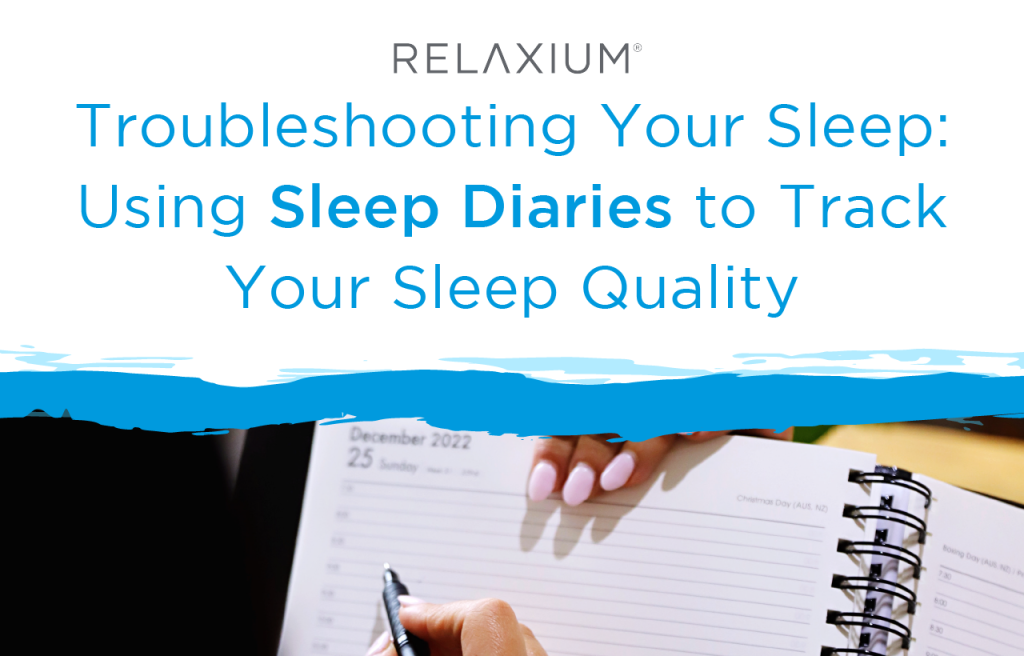Sleep diaries can help troubleshoot your sleep issues through analysis of your sleep patterns. Identify potential disruptions and take back control of your sleep!
Disruption of sleep is unfortunately very common. Millions of Americans struggle to get an adequate full night’s sleep. There are many ways to try to combat this issue but one that we are going to focus on is the use of sleep diaries!
We know this may not be a common thing you have probably heard of but don’t knock it before you try it!
What is a sleep diary?
A sleep diary is a tool that you can use to track and record different aspects of your individual sleep pattern and habits. It is used to keep a daily log of your sleep information. This information can then be used to identify sleep patterns/ identify areas for improvement.
Some of the most common information that goes in a sleep diary is:
- Bedtime and waketime
- Quality of sleep
- Duration of sleep
- Sleep latency
- Number of awakenings
- Sleep environment
- Daytime factors
- Nap information
- Daily activities
Bedtime and waketime
A great thing to note in a sleep diary is the time you wake up and the time you fall asleep. This can help to start to keep track of a pattern.
One of the best ways to improve your sleep schedule is to wake up and fall asleep at the same time, so if it is recorded you can know if you are following the schedule appropriately.

Quality of sleep
Probably one of the most important parts of the sleep diary, keeping track of your quality of sleep is extremely important. If a pattern emerges, a sleep disorder or factor may be able to be identified.
We advise you to rate your quality of sleep using a scale of some sort. Perhaps a rating from 1-10. Try to be as descriptive as possible.
Duration of sleep
Duration of sleep is also of course very telling of overall sleep. Try to make notes in your sleep diary of the hours and minutes of sleep you achieved.
If you are starting to see a pattern of sleep being better or longer on certain days, consider what occurs during the day to make that happen.
Sleep latency
Sleep latency is the amount of time it takes for you to fall asleep after getting into bed. Make note of how long you reckon you took to fall asleep once getting in bed.
A couple of sleep tips for this are:
- Stay off of technology at least 30 minutes before bed
- Create a consistent nighttime routine to signal to the body it is time to sleep
- Practice relaxation techniques
Doing these will help your mind and body to start to relax, making sleep more achievable.
Number of awakenings
As much as you can, try to keep track of the number of times you wake up at night. Brief awakenings should also be noted to try to see a recurring pattern.
Awakenings at night are one of the common symptoms of those who struggle to sleep. This is why our sleep supplement, Relaxium Sleep was developed. Relaxium Sleep is designed to help you fall asleep faster, stay asleep longer, and have you waking up feeling refreshed and alert.
Sleep environment
Sleep environment makes an enormous impact on sleep. Uncomfortable and unsupportive furniture as well as external factors can create a less than considerable sleep environment.
Make sure to describe the conditions of your sleep environment. Factors such as:
- Room temperature
- Bed/mattress support
- Noise
- Light
All can affect sleep, but the good thing is that many of these factors can be changed. A new mattress, sound machine, and black-out curtains, all are fantastic resources meant to help promote better sleep.

Daytime factors
What you do or do not do during the day can have a large factor on sleep. Some of the most common sleep disruptors that many engage in are:
- Excessive consumption of caffeine
- Excessive amounts of alcohol
- Low levels of physical activity
- Medications
- Stress levels
All have the capability to mess with the quality of sleep you have at night. Make sure to take note of what you did during the day to create a pattern.
Nap information
Many will take naps during the day. While we aren’t opposed to naps, we like to advise that when taking naps, make sure to keep them short as they can affect your tiredness for your prolonged sleep at night.
So make sure to record the time and duration of naps throughout the day. These will help to pinpoint some patterns as well.
Daily activities
Sometimes things will occur during the day that will affect the amount of sleep you get. In these cases, make note of any significant activities that occurred during the day. This can provide some great insight as they may have more of an impact on sleep than you may realize.

Patterns, patterns, patterns
Just as the classic diary is meant to help you to collect thoughts and insight, a sleep diary can help to specifically identify areas of need with sleep.
Relaxium offers a number of safe and effective supplements that aid in the categories of sleep, calm, focus, and immunity. Created by Clinical Neurologist, Dr. Eric Ciliberti, TryRelaxium.com offers a 30-day Money Back Guarantee trial of Relaxium Sleep to allow our users to truly experience its effects. To try the product today visit our website for more information.
To restful and healthy days ahead.
The Relaxium Team
*These statements have not been evaluated by the Food & Drug Administration. This product is not intended to diagnose, treat, cure, or prevent any disease.
Sources:

